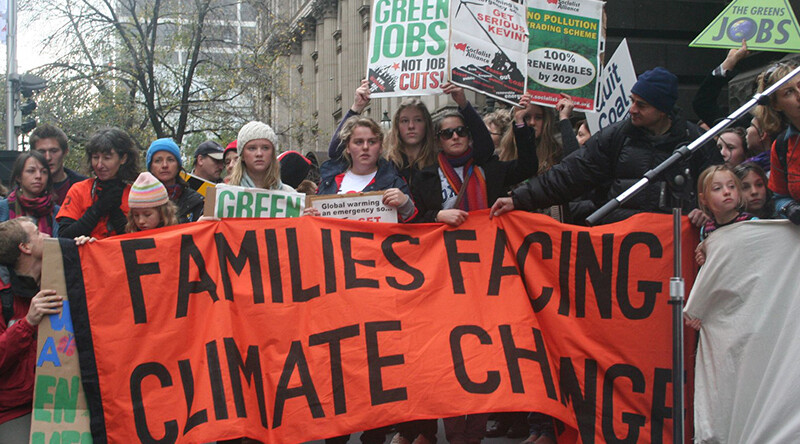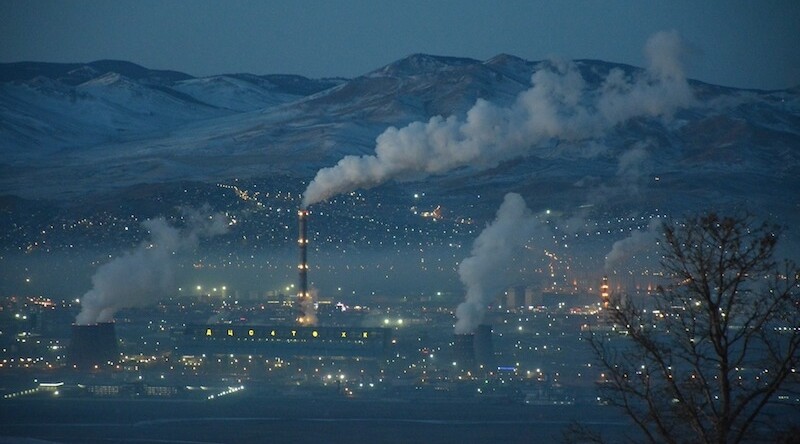In 2014, the United States Department of Defense published the Climate Change Adaptation Roadmap. This report states: "Rising global temperatures, changing precipitation patterns, climbing sea levels, and more extreme weather events will intensify the challenges of global instability, hunger, poverty, and conflict. They will likely lead to food and water shortages, pandemic disease, disputes over refugees and resources, and destruction by natural disasters in regions across the globe." The report also calls climate change a "threat multiplier," as it amplifies the existing issues that are already happening.
Now in 2019, we are seeing these predictions become reality. A noticeable effect is the rapid increase in populations displaced because of climate change, or "climate migrants." As climate change continues to act as a threat multiplier, world leaders will need to find creative solutions to protect this group of people.
One of the ways to do this is to consider amending Article I of the United Nations Convention Relating to the Status of Refugees to include climate migrants. Article I defines refugees as:
". . . someone who is unable or unwilling to return to their country of origin owing to a well-founded fear of being persecuted for reasons of race, religion, nationality, membership of a particular social group, or political opinion."
Adopted in 1951, the Convention provides protections to international refugees that are still in use today. For example, refugees should not be penalized for illegal entry or stay while seeking asylum. Refugees are also granted access to education, the ability to work, travel documents, and courts in the contracting state in which they reside. The Convention stems from Article 14 of the Universal Declaration of Human Rights, which states, "Everyone has the right to seek and enjoy in other countries asylum from persecution." The legislation has been amended only once (in 1967) since its implementation to provide the protections more universally. The original document limited the protection status only to people fleeing prior to 1951 and within Europe who fled or lost their homes due to the aftermath of World War II. The UN Refugee Agency estimates that, using this definition, there are 70.8 million people who are forcibly displaced worldwide and about 80 percent of them live in countries neighboring their countries of origin.
The challenge we face today is vastly different than when this definition of "refugee" was created. But just as in 1951, when people were dealing with poverty, persecution, and displacement due to aftershocks of World War II, there is again a moral right to protect our most vulnerable populations, this time due to climate change. With the United Nations 2019 Climate Summit happening in September, leaders should take this into consideration.
According to a 2018 report published by The World Bank, "Groundswell: Preparing for Internal Climate Migration," sub-Saharan Africa, Latin America, and South Asia could see over 143 million migrants move within their own regions by 2050. These three regions alone represent 55 percent of the developing world's population. In the report, World Bank CEO Kristalina Georgieva says, "Increasingly, we are seeing climate change become an engine of migration, forcing individuals, families and even whole communities to seek more viable and less vulnerable places to live." For example, in Ethiopia, lack of water availability and low crop yields are driving populations from rain-fed cropland areas. Also, in Bangladesh, 20 million people living near the coast have their health affected by the presence of saltwater in their drinking water supply.
In the Americas, farmers from Honduras, El Salvador, and Guatemala are fleeing with their families to the United States. A New York Times article stated that although poverty and violence are prime factors causing people to migrate, climate change is often the tipping point for people who make this decision. If people cannot earn an income and are also not able to feed themselves or their families, they will risk migrating. In the article, Dr. Edwin J. Castellanos, dean of the Research Institute at the Universidad del Valle de Guatemala, says, "Small farmers are already living in poverty; they're already at the threshold of not being able to survive . . . so any changes in the situation may push them to have enough incentives to leave."
Climate change has no borders and will affect all of us, even if it is initially affecting our neighbors. As families migrate looking for more stability, children and young people's educational pursuits are interrupted. We may see that educational systems will not be able to handle these migration patterns, which risks creating more poverty as people may not be able to prepare themselves for the jobs of the future.
A new report by the United Nations warns that land and sea resources are being exploited rapidly. As climate-related threats continue to worsen and our food supply dwindles, it will be difficult for a majority of the world's population to sustain itself. The report also adds that half a billion people are living in places that have turned into deserts over the last several decades, and agricultural fields are losing soil due to erosion at a rate between 10 to 100 times faster than it is forming. This situation is causing the displacement of populations at an exponential rate. The BBC reported that in 2018 a deadly drought displaced approximately 260,000 people from Afghanistan's Northern and Western regions. According to the United Nations, the drought displaced more Afghans than the Taliban conflict.
These displacement trends are not just seen in the developing world. In the United States, after Hurricane Maria hit in 2017, 2,300 Puerto Rican families were given temporary housing in the continental U.S. by the Federal Emergency Management Agency (FEMA), according to NBC News. In Alaska, the town of Newtok is losing about 70 feet of land each year due to coastal erosion, and according to Think Progress, it secured $15 million in funding to relocate. In Louisiana, as HuffPost reports, Isle de Jean Charles, home to the Isle de Jean Charles Band of the Biloxi-Chitimacha-Choctaw Tribe, is being relocated due to sea level rising; the island has lost more than 98 percent of its land since 1955.
As climate migration will surely increase over the coming years, world leaders should consider adopting policies to mitigate the situation, such as providing universal legal protection to climate migrants. This will give them recognition under the law and encourage countries to work together to find solutions. Countries could create a strategic plan to show how they are working on constructive solutions to minimize the displacement of populations and they would be held accountable if they are not upholding these criteria. Although the formal recognition of this population as refugees could create an untenable number of climate migrants, we should be proactive in looking for solutions, rather than reactive to a situation that continues to worsen. The implementation of universal legal protections could help countries that are not adopting sustainable practices to rethink their strategies and align towards more environmentally friendly resolutions and laws.
This is not impossible to do, as we previously found solutions to help people who have been displaced when regions of the world were in crisis. For example in 1921, Fridtjof Nansen, the first high commissioner for refugees the League of Nations, created the Nansen Passport. This document allowed thousands of people who were stateless or deprived of their national passports to enter and travel to other countries, as well as earn a living in their new nations. Some leaders today have also thought in this direction. In 2017, New Zealand's Prime Minister Jacinda Ardern considered creating a climate change refugee visa for Pacific Islanders after her country's immigration and protection tribunal rejected two families for refugee status because they did not fall under the 1951 Convention definition of a "refugee." This plan has not came to fruition, but it is worth considering and expanding to include more nations.
The aforementioned 2018 World Bank report also provided recommendations for mitigating internal climate migration by taking three steps. One step is lowering greenhouse emission gases by taking global climate action. Another is to embed climate migration in development planning in order to create better laws. Lastly, another recommendation is to invest in more evidence-based research to better understand climate migration. Georgieva states, "The number of climate migrants could be reduced by tens of millions as a result of global action to reduce greenhouse gas emissions and with far-sighted development planning. There is an opportunity now to plan and act for emerging climate change threats."
Fortunately, some are beginning to acknowledge that climate change is causing the displacement of populations. For example, the Global Compact for Safe, Orderly and Regular Migration, released in July 2018, calls for stronger analysis and information sharing to address migration due to natural disasters and climate. But leaders and policymakers should take it a step further and work on integrating climate migrants into international law. If amending the 1951 Convention may seem too controversial, then a Convention for the Legal Protections of Climate Migrants should be considered to protect the people currently affected by climate change and to encourage countries to address climate-related issues. Not doing so may strip future generations of the ability to have a stable standard of living and would risk violating their human rights. This year's Climate Summit at the United Nations is the perfect place to start this work.



